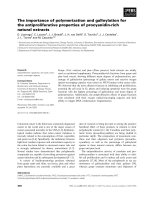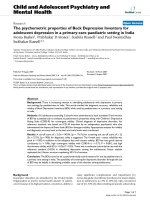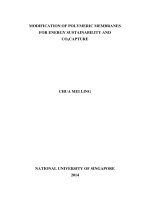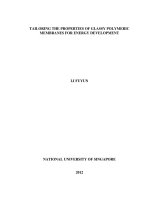Tailoring the properties of glassy polymeric membranes for energy development
Bạn đang xem bản rút gọn của tài liệu. Xem và tải ngay bản đầy đủ của tài liệu tại đây (4.94 MB, 225 trang )
TAILORING THE PROPERTIES OF GLASSY POLYMERIC
MEMBRANES FOR ENERGY DEVELOPMENT
LI FUYUN
NATIONAL UNIVERSITY OF SINGAPORE
2012
i
TAILORING THE PROPERTIES OF GLASSY POLYMERIC
MEMBRANES FOR ENERGY DEVELOPMENT
LI FUYUN
B. Tech. (Hons.), NUS
A THESIS SUBMITTED
FOR THE DEGREE OF DOCTOR OF PHILOSOPHY
DEPARTMENT OF CHEMICAL AND BIOMOLECULAR
ENGINEERING
NATIONAL UNIVERSITY OF SINGAPORE
2012
ii
DECLARATION
I hereby declare that the thesis is my original work and it has been written by me in its
entirety. I have duly acknowledged all the sources of information which have been used
in the thesis.
This thesis has also not been submitted for any degree in any university previously.
_________________
Li Fuyun
23 October 2012
i
ACKNOWLEDGEMENT
This thesis would not have been possible without the guidance, help and support of
several individuals who in one way or another contributed and extended their valuable
assistance in the preparation and completion of this study.
First and foremost, I am heartily thankful to my adviser, Prof. Neal Chung Tai-Shung,
whose encouragement, guidance, support and enthusiasm kept me moving through the
difficult period of this research. Besides the knowledge and skills that I have learnt, his
dedication, diligence and tireless energy in work has also enlightened me. I am also
indebted to my co-adviser, Assoc. Prof. Kawi Sibudjing for his continuous support and
invaluable comments throughout this study.
Special thanks are due to Dr. Li Yi and Dr. Xiao Youchang for their patience, steadfast
encouragement, and guidance during my PhD study. Many thanks go to Prof. Jean Y.C.
and Dr. Chen Hongmin at the University of Missouri-Kansas City for providing training
and help in analyzing positron annihilation spectroscope results. Besides, it has been
pleasant to work with people in Prof. Chung’s group. In particular, Dr. Peng Na, who had
discussion with me for the hollow fiber spinning; Mr. Ong Yee Kang and Miss Xing
Dingyu, who taught me ways of performing molecular simulation; and Ms Lin Huey Yi,
who helped me when I was lost in finding/ordering chemicals for research use. Very
special thanks go to Miss Chua Mei Ling & Miss Zhong Peishan, who were always
approachable when I have questions regarding to English writing.
ii
Additionally, I would like to gratefully acknowledge the financial support from the
National Research Foundation (NRF). I am grateful to the department of Chemical and
Biomolecular Engineering at the National University of Singapore (NUS) for providing
professional atmosphere for my PhD Study.
Lastly, my deepest gratitude goes to my family for their endless support, especially to my
dearest wife, Hung-Yun, whose unfailing love and persistent confidence in me, has taken
the load off my shoulder; and to my unborn baby girl for bringing me the best of luck this
year.
.
iii
TABLE OF CONTENTS
Pages
ACKNOWLEDGEMENT …………………………………………………………….
i
TABLE OF CONTENTS ……………………………………………………………
iii
SUMMARY …………………………………………………………………………
xi
LIST OF FIGURES …………………………………………………………………
xiv
LIST OF TABES ………………………………………………………………………
xix
CHAPTER ONE: INTRODUCTION ……………………………………………
1
1.1
Basic Concept of Membrane Separation ………………………………………
2
1.2
Gas Separation Membrane ………………………………………………………
4
1.3
Scientific Milestones of Gas Separation Membrane …………………………….
7
1.4
Gas Separation Membrane Applications ……………….……………………….
8
1.4.1
Air Separation Membranes ……………………………………………
8
1.4.2
Air Drying Membranes ………………………………………………….
9
1.4.3
Hydrogen Separation Membranes ………………………………………
10
1.4.4
Natural gas Upgrading Membranes ……………………………………
11
1.4.5
Carbon Dioxide Separation Membranes ………………………………
12
1.4.6
Organic Vapor Separation Membranes …………………………………
13
1.5
Goals and Organization of the Dissertation ……………………………………
14
1.5
References ……………………………………………………………………….
17
iv
CHAPTER TWO: BACKGROUND …
19
2.1
Solution-diffusion Mechanism ………………………………………………….
20
2.2
Transport Phenomena in Different Polymeric Systems …………………………
22
2.2.1
Gas Transport in Rubbery Polymers …………………………………….
22
2.2.2
Gas Transport in Glassy Polymers ……………………………………
23
2.2.3
Factors Affecting Gas Transport Properties …………………………….
25
2.2.3.1
Penetrant Size and Shape ………………………………………
25
2.2.3.2
Penetrant Condensability ………………………………………
26
2.2.3.3
Operating Temperature ………………………………………
26
2.2.3.4
Operating Pressure ……………………………………………
27
2.2.3.5
Glassy Transition Temperature ………………………………
28
2.2.3.6
Polymer Structure/Chain Mobility ……………………………
28
2.2.3.7
Fractional Free Volume (FFV) …………………………………
29
2.3
Membrane Structures ……………………………………………………………
30
2.3.1
Porous Membranes ……………………………………………………
30
2.3.2
Nonporous Membranes …………………………………………………
32
2.4
Design of Membrane Modules for Gas Separation ……………………………
33
2.4.1
Plate-and-frame Modules …………………………….…………………
33
2.4.2
Spiral-wound Modules ………………………………………………….
34
2.4.3
Hollow Fiber Modules …………………………………………………
34
2.5
References ……………………………………………………………………….
35
CHAPTER THREE: EXPERIMENTAL ………………………………………….
40
v
3.1
Materials …………………………………………………………………………
42
3.1.1
Polymers …………… ………………………………………………….
42
3.1.2
Nanoparticles …………………………
44
3.1.3
Others ……………………………………………………………………
44
3.2
Fabrication of Hybrid POSS
®
-Matrimid
®
-Zn
2+
Nanocomposite Dense Films for
the Separation of Natural Gas ………………………………………………….
45
3.2.1
Preparation of Hybrid POSS
®
Matrimid
Nanocomposite Membranes ….
45
3.2.2
Post-treatment of Hybrid POSS
®
Matrimid
Nanocomposite Membranes .
46
3.3
Development of High-Performance Thermally self-cross-linked Polymer of
Intrinsic Microporosity (PIM-1) Membranes for Energy Development ………
47
3.3.1
Synthesis of PIM-1 ………………….………………………………….
47
3.3.2
Dense Membrane Preparation ……………… …………………………
49
3.3.3
Thermal Cross-Linking Treatments …………………………………….
49
3.4
Fabrication of the UV-Rearranged PIM-1 Polymeric Membranes for Advanced
Hydrogen Purification and Production ………………………………………….
50
3.4.1
UV Irradiation Treatments …………………………………………….
50
3.5
Development and Positron Annihilation Spectroscopy (PAS) Characterization
of Polyamide imide (PAI)-Polyethersulfone (PES) based Defect-free Dual-
Layer Hollow Fiber Membranes with an Ultrathin Dense-selective Layer for
Gas Separation …………………………………………………………………
50
3.5.1
Dope Formulation …………………………………….………………
50
3.5.2
Spinning Process and Solvent Exchange ………………………………
51
3.5.3
Calculation of the Elongational Rate …………………………………….
53
vi
3.6
Characterization of Physical Properties …………………………………………
54
3.6.1
Brunauer-Emmett-Teller (BET) …………………………… ………….
54
3.6.2
Thermogravimetric Analysis (TGA) ……………………… …………
54
3.6.3
Differential Scanning Calorimetry (DSC) ………………………………
55
3.6.4
Wide Angle X-ray Diffraction (WAXD) …………………… ………
55
3.6.5
Fourier Transform Infrared Spectrometer (FTIR) ……………………….
56
3.6.6
X-ray Photoelectron Spectrometer (XPS) ……………………………….
56
3.6.7
Nuclear Magnetic Resonance (NMR) …………………………………
56
3.6.8
Gel-Permeation Chromatography (GPC) ……………………………….
57
3.6.9
Gel Content Analysis …………………………………………………….
57
3.6.10
Scanning Electron Microscope (SEM) ………………………………….
58
3.6.11
Energy Dispersion of X-ray (EDX) …………………………………….
58
3.6.12
Density Measurement and Fractional Free Volume (FFV) ……………
59
3.6.13
Positron Annihilation Spectroscopy (PAS) ……………………………
59
3.6.14
Molecular Simulation …………………………………………………
63
3.7
Characterization of Gas Transport Properties …………………………………
63
3.7.1
Pure Gas Permeation Test ………………………………………………
63
3.7.1.1
Dense Film ……………………………………………………
63
3.7.1.2
Hollow Fiber ……………………………………………………
66
3.7.2
Mixed Gas Permeation Test ……………………………………………
69
3.7.2.1
Dense Film ……………………………………………………
69
3.7.2.2
Hollow Fiber …………………………………………………
70
3.7.3
Pure Gas Sorption Test ………………………………………………….
71
vii
3.7.4
Physical Aging Test …………………………………………………….
73
3.8
References ……………………………………………………………………….
73
CHAPTER FOUR: FACILITATED TRANSPORT BY HYBRID POSS
®
-
MATRIMID
®
-Zn
2+
NANOCOMPOSITE MEMBRANE
FOR THE SEPARATION OF NATURAL GAS …………
77
4.1
Introduction ……………………………………………………………………
78
4.2
Results and Discussion ………………………………………………………….
82
4.2.1
Effect of POSS
®
Loadings on Membrane Properties …………………
82
4.2.2
Characterization of Hybrid POSS
®
-Matrimid
®
-Zn
2+
Nanocomposite
Membranes ……………………………………………………….……
87
4.2.3
Effect of ZnCl
2
Concentration on Gas Separation Performance ……….
90
4.3
Conclusions ……………………………………………………………………
94
4.4
References ………………………………………………………………………
95
CHAPTER FIVE: HIGH-PERFORMANCE THERMALLY SELF-CROSS-
LINKED POLYMER OF INTRINSIC MICROPOROSITY
(PIM-1) MEMBRANES FOR ENERGY DEVELOPMENT
100
5.1
Introduction ……………………………………………………………………
101
5.2
Results and Discussion ………………………………………………………….
104
5.2.1
Characterization of the Thermally Cross-Linked PIM-1 Membranes …
104
5.2.2
Pure Gas Transport Properties …………………………………….…….
110
5.2.3
Mixed Gas Tests and Potential Applications of Thermally Cross-Linked
viii
PIM-1 Membranes …………………………………………… ……….
118
5.3
Conclusions ……………………………………………………………………
123
5.4
References ……………………………………………………………………….
125
CHAPTER SIX: UV-REARRANGED PIM-1 POLYMERIC MEMBRANES
FOR ADVANCED HYDROGEN PURIFICATION AND
PRODUCTION …
131
6.1
Introduction ……………………………………………………………………
132
6.2
Results and Discussion ………………………………………………………….
134
6.2.1
Structural Determination and Characterization of UV-Irradiated PIM-1
Membranes ………………………………………………………………
134
6.2.2.1
Is There a Cross-Linking Reaction during the UV-Irradiation
Process? …………………………………………………………
134
6.2.2.2
Structural Determination of the UV-Irradiated PIM-1
Membrane ………………………………………………………
137
6.2.2
Pure Gas Separation Performance ….…………………………….……
142
6.2.3
Mixed Gas Separation Performance and the Upper Bound Comparison .
153
6.3
Conclusions ……………………………………………………………………
156
6.4
References ……………………………………………………………………….
158
CHAPTER SEVEN: DEVELOPMENT AND POSITRON ANNIHILATION
SPECTROSCOPY (PAS) CHARACTERIZATION OF
POLYAMIDE IMIDE (PAI)-POLYETHERSULFONE
(PES) BASED DEFECT-FREE DUAL-LAYER HOLLOW
ix
FIBER MEMBRANES WITH AN ULTRATHIN DENSE-
SELECTIVE LAYER FOR GAS SEPARATION ………
162
7.1
Introduction ……………………………………………………………………
163
7.2
Results and Discussion ………………………………………………………….
166
7.2.1
Defect-free PAI-PES Dual-layer Hollow Fiber Membranes with an
Ultrathin Dense-selective Layer for Gas separation …………………….
166
7.2.1.1
Morphological Integrity of as-spun PAI-PES Dual-layer Hollow
Fiber Membranes … …………………………………………
166
7.2.1.2
The Effect of Take-up Rate on as-spun PAI-PES Dual-layer
Hollow Fiber Membranes ……………………………………
170
7.2.1.3
The Effect of Outer-layer Dope Flow Rate on as-spun PAI-PES
Dual-layer Hollow Fiber Membranes ………………………….
172
7.2.2
PAS Analysis of Dual-layer PAI-PES Hollow Fiber Membranes …….
173
7.2.2.1
S Parameters from DBES Experiments for as-spun PAI-PES
Dual-layer Hollow Fiber Membranes …………………………
173
7.2.2.2
R Parameters from DBES Experiments for as-spun PAI-PES
Dual-layer Hollow Fiber Membranes …………………………
176
7.2.3
Correlation of VEPFIT Data with Gas Separation Performance of Dual-
layer PAI-PES Hollow Fiber Membranes …………………………….…
178
7.3
Conclusions ……………………………………………………………………
182
7.4
References ………………………………………………………….……………
184
CHAPTER EIGHT: CONCLUSIONS AND RECOMMENDATIONS ………….
189
x
8.1
Conclusions ………………………………………………………………….…
190
8.1.1
Fabrication of Hybrid POSS
®
-Matrimid
®
-Zn
2+
Nanocomposite Dense
Films for the Separation of Natural Gas ………………………………
191
8.1.2
High-Performance Thermally self-cross-linked Polymer of Intrinsic
Microporosity (PIM-1) Membranes for Energy Development …….……
192
8.1.3
UV-Rearranged PIM-1 Polymeric Membranes for Advanced Hydrogen
Purification and Production ………………………………………….….
193
8.1.4
Development and Positron Annihilation Spectroscopy (PAS)
Characterization of Polyamide imide (PAI)-Polyethersulfone (PES)
based Defect-free Dual-Layer Hollow Fiber Membranes with an
Ultrathin Dense-selective Layer for Gas Separation …………… …….
195
8.2
Recommendations for future work ………………………………………….…
196
8.2.1
Continuous Feasibility Studies of the Postmodified PIM-1 Membranes
for Industry Use …………………………………………………………
196
8.2.2
Hollow Fiber Spinning of the PIM-1 based Polymeric Membrane for
Gas Separation …………………………………………………….…….
198
PUBLICATIONS ………………………………………………………………….…
200
xi
SUMMARY
Membrane gas separation and technology has attracted great interest in the recent years
due to the simplicity, ease of scale-up and environmental friendliness of membrane
processes. The use of membranes in the separation of gases is a fast-growing field. In
various cases, gas separation membrane technology has been widely used in industrial
gas separations, for example, oxygen- or nitrogen-enrichment in air separations,
hydrogen separation and natural gas upgrading. However, traditional membrane materials
cannot always achieve high degrees of separation performance and suffer from an upper-
bound relationship for its permeability and selectivity. This greatly constrains the
application of polymeric materials for industrial use. In this PhD work, the main focus is
to explicitly tailor the properties of glassy polymeric membranes for gas separation
application. Four aspects have been thoroughly investigated.
Firstly, the hybrid nanocomposite membranes were fabricated by incorporation of nano-
sized POSS
®
particles into commercially available Matrimid
®
for the separation of
natural gas. It was observed that the nano-sized POSS
®
particles could be distributed
uniformly over the Matrimid
®
matrix with an intimate polymer-particle interface. This is
presumably ascribed to the organic-inorganic nature of POSS
®
particles and the existence
of intermolecular hydrogen bonding between the carboxylic groups of POSS
®
and
Matrimid
®
. The introduction of POSS
®
nanoparticles enhanced the toughness of the
membrane films. After that, the nanocomposite membranes were post-treated with ion
exchange by soaking into the ZnCl
2
/MeOH solution. In fact, the excellent dispersion of
xii
POSS
®
with eight carboxylic functional groups which each moiety provided a high-
density ionic binding platform for the introduction of Zn
2+
. The hybrid POSS
®
-
Matrimid
®
-Zn
2+
revealed a substantial enhancement in natural gas (i.e., separation of
CO
2
/CH
4
) separation performance which is resulted from the facilitated transport of CO
2
with the existence of Zn
2+
. The effect of various ZnCl
2
concentrations was also studied.
Secondly, a new type of polymer, called polymers of intrinsic microporosity (i.e., PIM-1)
was synthesized in our laboratory. The original PIM-1 has very high gas permeability but
relatively low gas pair selectivity. In this part, the PIM-1 membrane films were
undergone thermal treatment to induce self-cross-linking. The occurrence of cross-linking
reaction with the formation of triazine rings have been verified by FTIR, TGA, XPS and
gel content analyses. The resultant cross-linked membranes exhibited exceptional gas
separation performance that surpassed the most recent upper bound for the state-of-the-
art polymeric membranes for the important gas separation, such as hydrogen purification,
CO
2
capture and flue gas separation. For example, PIM-1 thermally treated at 300 °C for
2 days has the CO
2
permeability of 4000 barrer with CO
2
/CH
4
and CO
2
/N
2
ideal
selectivity of 54.8 and 41.7, respectively. The effect of thermal soaking duration was also
studied in this work.
Thirdly, to continue from the previous work, another postmodification was carried out on
PIM-1 dense films. Under the continuous ultraviolet (UV) irradiation process, the
original CO
2
selective PIM-1 has turned to H
2
selective. This is due to the significantly
enhanced diffusivity selectivity induced by UV radiation, followed by molecular
xiii
rearrangement, conformation change and chain packing. It has been proven that the
polymer chains of PIM-1 experienced 1-2-migration reaction and transformed to close-to-
planar like rearranged structure after UV radiation. The positron annihilation lifetime
(PAL) and molecular simulation have confirmed the chemical and structural changes
during the UV radiation process. The PIM-1 membrane after UV radiation for 4 hours
showed H
2
permeability of 452 barrer with H
2
/CO
2
selectivity of 7.3, which was one of
the best ever reported in the literature.
Considering the importance of hollow fiber for industry use, the formation of defect-free
dual-layer hollow fiber membrane with an ultra-thin dense-selective layer has also been
studied. It has been observed that an optimization in the velocity between the inner-layer
and the outer-layer dopes at the exit of the spinneret is essential to minimize additional
stresses and defect formation in the outer functional layer. Positron annihilation
spectroscopy (PAS) has been used for the first time to explore the morphology and
predict the gas separation performance of PAI–PES based dual-layer hollow fiber
membranes. Doppler broadening energy spectra (DBES) from PAS accurately estimate
the outer-layer thickness and demonstrate the existence of the multilayered structure of
the dual-layer hollow fiber membranes. The success in the formation of defect-free
hollow fiber membrane with an ultra-thin dense-selective layer for gas separation is
paramount for industrial use as the defect free membrane would minimize the post-
treatment process and save production cost, while the ultra-thin dense-selective layer
maximizes the efficiency of hollow fiber membrane.
xiv
LIST OF FIGURES
Pages
Figure 1.1
Schematic diagram of membrane separation ………………………
2
Figure 1.2
Membrane classifications based on the membrane pore size ………
4
Figure 1.3
Scientific milestones of membrane gas separation ………………
8
Figure 2.1
Illustration of dual-mode sorption model …………………………
24
Figure 3.1
Ionic binding process of hybrid POSS
®
-Matrimid
®
nanocomposite
membrane with ZnCl
2
………………………………………………
47
Figure 3.2
Synthesis of polymer of intrinsic microporosity (PIM-1) ………….
48
Figure 3.3
Schematic diagram of the lab-scale hollow fiber spinning line ……
53
Figure 3.4
Schematic diagram of the dense film gas permeation testing cell …
64
Figure 3.5
Schematic diagram of the double O-ring permeation cell …………
65
Figure 3.6
Pure gas permeation testing apparatus for the polymeric hollow
fibers ………………………………………………………………
67
Figure 3.7
Schematic diagram of the mixed gas permeation test system for
dense films …………………………………………………………
69
Figure 3.8
Mixed gas setup for the hollow fiber membranes ………………….
71
Figure 3.9
Schematic diagram of the microbalance sorption cell ……………
72
Figure 4.1
EDX-SEM image of 20wt% POSS
®
-Matrimid
®
nanocomposite
with the distribution of silicon element in the cross-section ……….
82
Figure 4.2
The cross-section SEM images of nanocomposite membranes at
different POSS
®
loadings (a, b: 10wt% POSS
®
loading and 20wt%
POSS
®
loading, respectively) ……………………………………
84
xv
Figure 4.3
Line-scan EDX-SEM images of 20wt% POSS
®
-Matrimid
®
nanocomposite membranes treated with different molar
concentrations of ZnCl
2
…………………………………………….
88
Figure 4.4
Zn 2p
3/2
and Zn 2p
1/2
XPS spectra of pure ZnCl
2
and 0.2M
ZnCl
2
/MeOH treated 20wt% POSS
®
-Matrimid
®
nanocomposite
membrane …………………………………………………………
89
Figure 4.5
CO
2
sorption isotherms of 20wt% POSS
®
-Matrimid
®
nanocomposite membrane before and after the ionic binding
treatment with ZnCl
2
……………………………………………….
92
Figure 5.1
TGA of the original and the thermally cross-linked PIM-1
membranes …………………………………………………………
105
Figure 5.2
Proposed thermal cross-linking reaction of PIM-1
106
Figure 5.3
FTIR spectra of the original and the thermally cross-linked PIM-1
membranes …………………………………………………………
107
Figure 5.4
N
1s
XPS analysis of the original and the thermally cross-linked
PIM-1 membranes
109
Figure 5.5
Two-dimensional representations of the contorted PIM-1
membrane before and after thermal cross-linking reaction with the
formation of triazine rings. (a): Original PIM-1 matrix (Time = 0);
(b): Initiation of thermal cross-linking process (Time >> 0); (c):
Completion of thermal cross-linking process (Time >>> 0) ……….
116
Figure 5.6
PAL analysis of the original and the thermally cross-linked PIM-1
membranes
118
xvi
Figure 5.7a
Upper bound comparison (H
2
/N
2
, H
2
/CH
4
and O
2
/N
2
): PIM-PIM-8
(▲), PIM-1 (∆), PIM-1/silica MMM (○), Carboxylated PIM-1 (♦),
UV-cross-linked PIM-1 (●) …
121
Figure 5.7b
Upper bound comparison (CO
2
/CH
4
, and CO
2
/N
2
): PIM-PIM-8
(▲),PIM-1 (∆), Carboxylated PIM-1 (♦),UV-cross-linked PIM-1
(●), Tetrazole-functionalized PIM-1 (▼),Thermally rearranged
(TR) polymer (■) ……………………
122
Figure 5.8
Aging behavior of the original and the thermally cross-linked PIM-
1 membranes ……………………………………………………….
123
Figure 6.1
TGA analyses of the original and the UV-irradiated PIM-1
membranes …………………………………………………………
135
Figure 6.2
FTIR spectra of the original and the UV-irradiated PIM-1
membranes …………………………………………………………
136
Figure 6.3
Proposed mechanism for the photochemical reaction of PIM-1
membranes …………………………………………………………
138
Figure 6.4
1
H NMR analyses of the original and the UV-irradiated PIM-1
membranes………………………………………………………….
140
Figure 6.5
XRD analysis of the original and the UV-irradiated PIM-1
membranes …………………………………………………………
142
Figure 6.6
Effect of UV-irradiation time on relative permeability (P/P
o
) for
various gases. The lines connected between data points are for eye-
guide purpose only …………………………………………………
145
Figure 6.7
PAL analysis of the original and UV cross-linked PIM-1
xvii
membranes …………………………………………………………
147
Figure 6.8
Molecular simulation of (a) the original PIM-1 and (b) the UV-
rearranged PIM-1 …………………………………………………
148
Figure 6.9
Simulated amorphous cells of (a) the original PIM-1 and (b) the
UV-rearranged PIM-1 (grey: Van der Waals surface; blue:
Connolly surface with probe radius of 1.45 Å) …………………….
149
Figure 6.10
Effect of UV-irradiation time on gas-pair selectivity. The lines
connected between data points are for eye-guide purpose only ……
152
Figure 6.11
Upper bound comparison (H
2
/N
2
, O
2
/N
2
, CO
2
/CH
4
and H
2
/CO
2
):
Poly(imidesiloxane) copolymer ( ),Polysulfone/zeolite 3A MMM
( ),6FDA-NDA-PDA (90 min) ( ), PBI/ZIF-7 MMM ( ) ……….
156
Figure 7.1
Cross-section morphologies of dual-layer hollow fiber membranes
with two different inner-dope compositions. A and B are fibers
spun with inner-layer dope compositions of PES/NMP/DG
(27/42/31) and PES/NMP/DG (32/48/20), respectively …………
167
Figure 7.2
Surface morphologies of dual-layer hollow fiber membranes with
two different inner dope compositions. A and B are fibers spun
with inner-layer dope compositions of PES/NMP/DG (27/42/31)
and PES/NMP/DG (32/48/20), respectively ……………………….
169
Figure 7.3
S parameters from DBES for the fibers spun at different take-up
rates as a function of incident positron energy (or mean depth).
Conditions A, B, C and D correspond to the spinning take-up rates
of 9.6, 14.5, 18.5 and 22.9 m/min, respectively. The lines
xviii
connected between data points are for eye-guide purpose only ……
175
Figure 7.4
Comparison of FESEM images of outer layer and outer edges of
the dual-layer PAI
-PES hollow fibers spun at different take-up
rates. Conditions A, B, C and D correspond to the spinning take-up
rates of 9.6, 14.5, 18.5 and 22.9 m/min, respectively ……………
176
Figure 7.5
R parameters from DBES for the fibers spun at different take-up
rates as a function of incident positron energy (or mean depth).
Conditions A, B, C and D correspond to the spinning take-up rates
of 9.6, 14.5, 18.5 and 22.9 m/min respectively. The lines are fitted
results from the VEPFIT program ………………………………….
177
Figure 7.6
Experimental O
2
/N
2
selectivity and fitted R
1
parameter as a
function of elongational rate. Conditions A, B, C and D correspond
to the spinning take-up rates of 9.6, 14.5, 18.5 and 22.9 m/min,
respectively. The lines connected between data points are for eye-
guide purpose only …………………………………………………
179
Figure 7.7
Experimental O
2
permeance and VEPFIT fitted skin thicknesses as
a function of FESEM measured outer layer thickness. Conditions
A, B, C and D correspond to the spinning take-up rates of 9.6,
14.5, 18.5 and 22.9 m/min, respectively. The dotted lines are for
eye-guide purpose only …………………………………………….
182
xix
LIST OF TABLES
Pages
Table 1.1
Membrane classifications based on driving force …………………
3
Table 1.2
Major suppliers of membrane natural gas separation systems ……
12
Table 1.3
Comparison of major CO
2
separation processes ……………………
13
Table 2.1
Gas properties in correlating sorption and transport properties …….
25
Table 3.1
Physical properties of Matrimid
®
, Torlon
®
, PES and PIM-1 and
POSS Amic Acid …………………………………………………
43
Table 3.2
Dual-layer PAI
-PES hollow fiber spinning conditions ……………
52
Table 4.1
Comparison of gas separation performance of pure Matrimid
®
and
hybrid nanocomposite membranes at different POSS
®
loadings …
85
Table 4.2
Comparison of glass transition temperatures of pure Matrimid
®
and
hybrid nanocomposite membranes at different POSS
®
loadings …
86
Table 4.3
Comparison of XRD results of pure Matrimid
®
and hybrid
nanocomposite membranes treated with different molar
concentrations of ZnCl
2
…………………………………………….
90
Table 4.4
Comparison of gas separation performance of hybrid 20wt%
POSS
®
-Matrimid
®
nanocomposite membranes treated with different
molar concentrations of ZnCl
2
………………………………………
91
Table 5.1
Pure gas separation performance of the original and the thermally
cross-linked PIM-1 membranes (Tested at 35
o
C and 3.5 atm) ……
112
Table 5.2
PAL results of the original and the thermally cross-linked PIM-1
xx
membranes …………………………………………………………
114
Table 5.3
Mixed gas separation performance of the thermally cross-linked
PIM-1 membrane PIM-300-2.0d (Tested at 35
o
C and 7.0 atm) ……
120
Table 6.1
Pure gas separation performance of the original and UV-irradiated
PIM-1 membranes at the different UV irradiation time (Tested at
35
o
C and 3.5 atm) …………………………………………………
144
Table 6.2
Sorption results of the original and the UV-irradiated PIM-1
membranes (Tested at 35
o
C) ………………………………………
146
Table 6.3
Mixed gas separation performance of the UV-irradiated PIM-1
membranes (Tested at 35
o
C and 7.0 atm) …………………………
154
Table 7.1
Gas separation performance of dual-layer hollow fiber membranes
at different take-up rates …………………………………………….
171
Table 7.2
Pure gas separation performance of dual-layer hollow fiber
membranes at various outer-layer dope flow rates ………………….
173
Table 7.3
VEPFIT results for the analysis of multilayered structure of dual-
layer hollow fiber membranes spun at different take-up rates ……
181
1
CHAPTER ONE
INTRODUCTION
2
1.1 BASIC CONCEPT OF MEMBRANE SEPARATION
Membrane separation is a technology which selectively separates species or components
(i.e., molecules, particles or polymers) in a gaseous and/or liquid mixture solution via
pores in the molecular arrangement of a semipermeable continuous structure [1]. The
components that are passed through the membrane are usually termed as permeate, while
those being rejected by the membrane are called retentate as shown Figure 1.1.
Figure 1.1: Schematic diagram of membrane separation
Due to its simplicity and great saving in energy consumption, membrane technology has
been applied in all types of industrial downstream separation and upstream treatment
processes. For instance, reverse osmosis was demonstrated as requiring an energy load
about 10 times lower than that of a thermal process [2]. Therefore, in various areas,
membrane technology is considered to be the dominant technology, such as in seawater









